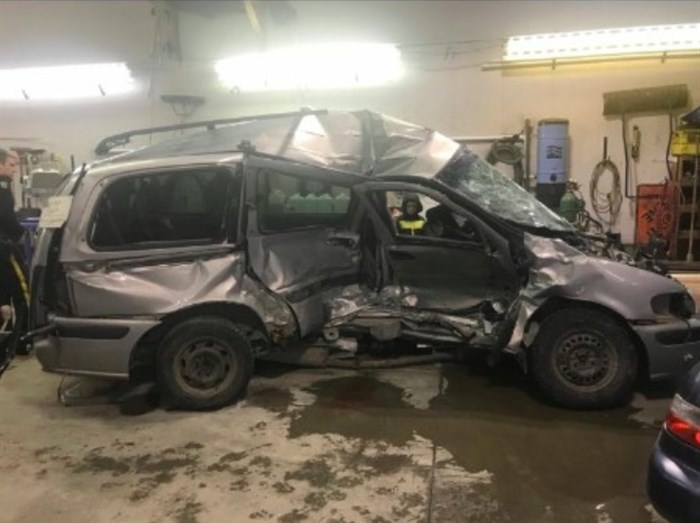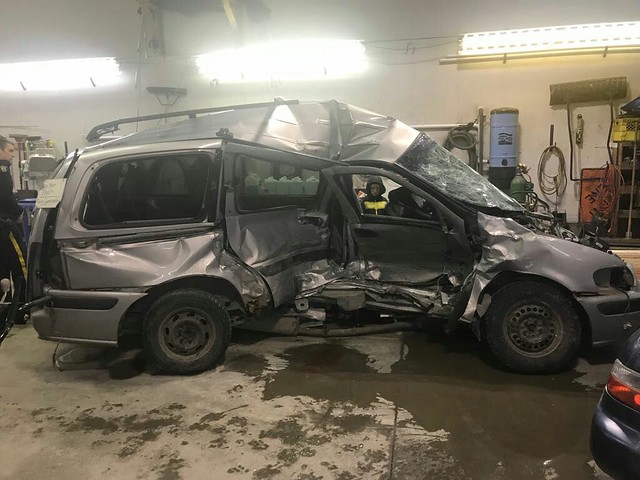
The minivan 18-year-old Rebecca Kimmel was driving when she crashed on Highway 6 Feb. 5, 2018 and died of her injuries. (Photo used with permission)
Image Credit: SUBMITTED
February 09, 2018 - 6:30 PM
NORTH OKANAGAN - Reminders about road safety are being shared after what has so far been a deadly winter on local roads.
Residents in the North Okanagan have been rocked by a number of fatal crashes this fall and winter.
On Nov. 2, a male in his late teens from Kelowna died in a collision with a school bus near Falkland. On Jan. 16, a six-year-old Alberta child died in a crash on Highway 97A, followed by another fatality that evening near Falkland, when a 32-year-old man from the Kootenays was killed. A few days later, a Coldstream man was killed in a crash Jan. 19 near Vernon, and on Feb. 5, an 18-year-old Vernon teen died in a crash on Highway 6. An online fundraiser has been created to help her family with funeral expenses.
But if you think this winter has been much worse than most, sadly you’d be wrong.
Fatal crash statistics from ICBC weren’t immediately available, however the Vernon RCMP provided unofficial numbers suggesting the numbers have been pretty similar the past few years.
Between Nov. 1, 2014 and March 31, 2015, there were four fatalities in the North Okanagan, followed by three during the same time period the following winter (2015/16), and five the next (2016/17). From Nov. 1, 2017 to today’s date, there have been five fatal crashes. If, over the next couple of months, there are any additional fatalities, the number could rise above the usual average from the past few winters.
B.C. Coroners Service spokesperson Andy Watson says all of this winter’s fatalities remain open for investigation, and couldn’t comment on exact causes.
A number of crashes occurred during periods of heavy snowfall, and emergency personnel even had to slow down for their own safety due to poor road conditions on their way to the Feb. 5 fatal on Highway 6.

Photos of the minivan Rebecca Kimmel, 18, was driving when it collided with a pick-up truck (used with permission). *Warning Graphic Content*
Speaking generally, Watson says anyone travelling in winter conditions should take precautions.
“In winter weather, the highways can be slippery, snow covered and with whiteout conditions in some places,” Watson says. “Travelling through mountain passes, weather can change suddenly. Plan ahead. Have an emergency kit in your car, including a first aid kit. And if you don’t need to travel in bad conditions, postpone travel plans until another time.”
Vernon RCMP have also urged people to be mindful of winter driving conditions following a number collisions — both fatal and non-fatal — this season.
“Snowy, icy conditions can seriously reduce visibility on our roads and make it difficult to stop and steer. In poor weather conditions, slow down, increase your following distance and give yourself plenty of time to get to your destination,” RCMP spokesperson Const. Kelly Brett says.
She suggests slowing down and increasing your following distance to at least four seconds — something that will give you room if you, or another driver, lose control.
“Black ice is virtually impossible to see ahead of time. That’s why it’s so important to slow down and keep your distance from other vehicles – so you can see how the vehicles around you are moving on the road,” Brett says.
If you start to skid, ease off the accelerator and look and steer smoothly in the direction you want to go, Brett says.
“Be careful not to over-steer and don’t brake — this could make the situation worse. You may need to repeat this manoeuvre several times until you regain control,” she says.
When snow melts, it can also build up on your vehicle’s headlights and in the wheel wells, which can affect your ability to see and steer so you should clear this off before driving.
When driving in slushy conditions, watch out for ridges of slush that can build up between lanes.
“To change lanes, wait for an area that has the least amount of slush, signal well in advance and slowly complete your lane change,” Brett says.
And when the roads are really bad, it may be best to just stay home, or find another way to work.
“When severe winter conditions arrive, consider alternatives to help you get to work safely. Take transit if possible, work from home or adjust your hours of work to avoid rush hour traffic,” Brett says.
To contact a reporter for this story, email Charlotte Helston or call 250-309-5230 or email the editor. You can also submit photos, videos or news tips to the newsroom and be entered to win a monthly prize draw.
We welcome your comments and opinions on our stories but play nice. We won't censor or delete comments unless they contain off-topic statements or links, unnecessary vulgarity, false facts, spam or obviously fake profiles. If you have any concerns about what you see in comments, email the editor in the link above.
News from © iNFOnews, 2018